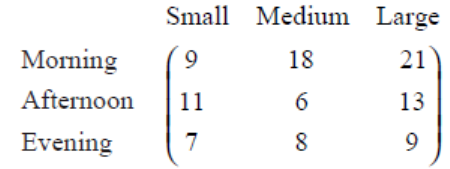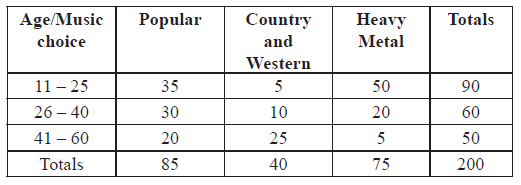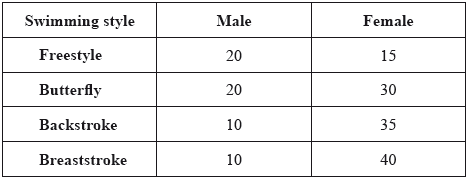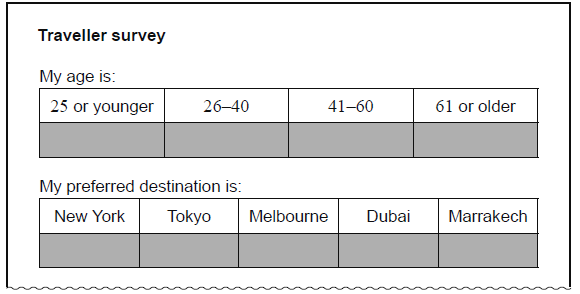Question
The local park is used for walking dogs. The sizes of the dogs are observed at different times of the day. The table below shows the numbers of dogs present, classified by size, at three different times last Sunday.

Write a suitable null hypothesis for a \(\chi^2\) test on this data.[1]
Write down the value of \(\chi^2\) for this data.[2]
The number of degrees of freedom is 4. Show how this value is calculated.[1]
The critical value, at the 5% level of significance, is 9.488.
What conclusion can be drawn from this test? Give a reason for your answer.[2]
Answer/Explanation
Markscheme
H0: The size of dog is independent of the time of day, (or equivalent) (A1)
Award (A0) for ‘no correlation’ (C1)[1 mark]
\(\chi^2 = 4.33\). (accept 4.328) (M1)(A1)
Note: GDC use is anticipated but candidates might calculate this by hand. (M1) can be awarded for a reasonable attempt to use the formula. (C2)[2 marks]
\((3–1)(3–1) = 4\) (A1)
Award mark for left hand side seen. (C1)[1 mark]
The hypothesis should not be rejected, (allow ‘accept H0’)
OR
The size of dog is independent of the time of day (A1)(ft)
\(4.33 < 9.488\) or \(0.363 > 0.05\) (R1)(ft)
Allow \(\chi_calc^2 < \chi_crit^2\) only if a value for \(\chi_calc^2\) is seen somewhere.
Note: Award (R1)(ft) for comparing the values and (A1)(ft) if the conclusion is valid according to the comparison given. If no reason is given, or if the reason is wrong both marks are lost. Note that (A0)(R1)(ft) can be awarded but (A1)(R0) cannot. (C2)[2 marks]
Question
\(200\) people of different ages were asked to choose their favourite type of music from the choices Popular, Country and Western and Heavy Metal. The results are shown in the table below.

It was decided to perform a chi-squared test for independence at the \(5\% \) level on the data.
Write down the null hypothesis.[1]
Write down the number of degrees of freedom.[1]
Write down the chi-squared value.[2]
State whether or not you will reject the null hypothesis, giving a clear reason for your answer.[2]
Answer/Explanation
Markscheme
Choice of music is independent of age. (A1) (C1)[1 mark]
\((3 – 1)(3 – 1)\)
\( = 4\) (A1) (C1)[1 mark]
\({\chi ^2} = 51.6\) (A2) (C2)
Note: \(52\) is an accuracy penalty (A1)(A0)(AP).[2 marks]
\(p{\text{-value}} < 0.05\) for \(5\% \) level of significance (R1)(ft)
or \(51.6 > {\chi ^2}_{crit}\)
Reject the null hypothesis (do not accept the null hypothesis). (A1)(ft) (C2)
Note: Do not award (R0)(A1).[2 marks]
Question
A questionnaire was given to all members of a school community to find out which drink was the most popular to have with breakfast. The results are given in the table below, classified by age.

A \(\chi^2\) test was conducted to decide whether the type of drink was independent of age.
Find the number of degrees of freedom for the \(\chi^2\) test.[2]
Write down the null hypothesis for the \(\chi^2\) test.[1]
The critical value for the \(\chi^2\) test at the 5% significance level is 12.59. The \(\chi^2\) test statistic is calculated to be 146 with a p-value of 6.62 × 10−29 (both numbers given correct to 3 significant figures).
Write down the conclusion reached at the 5 % significance level. Give a clear reason for your answer.[2]
Answer/Explanation
Markscheme
\( (3 – 1)(4 -1) \) (M1)
= 6 (A1) (C2)[2 marks]
The preferred type of drink is independent of age. (A1) (C1)
Note: For independent accept “not associated” but do not accept “not related” or “not correlated”[1 mark]
Reject null hypothesis as critical value \( < \chi_{calc}^2\) (A1)(R1)(ft)
Note: (ft) from their value in (c).
OR
Reject null hypothesis as p-value \(< 0.05\) (A1)(R1) (C2)
Notes: Do not award (A1)(R0).
Award the (R1) for comparison of correct values.[2 marks]
Question
Tony wants to carry out a \({\chi ^2}\) test to determine whether or not a person’s choice of one of the three professions; engineering, medicine or law is influenced by the person’s sex (gender).
State the null hypothesis, H0, for this test.[1]
Write down the number of degrees of freedom.[1]
Of the 400 people Tony interviewed, 220 were male and 180 were female. 80 of the people had chosen engineering as a profession.
Calculate the expected number of female engineers.[2]
Tony used a 5 % level of significance for his test and obtained a p-value of 0.0634 correct to 3 significant figures.
State Tony’s conclusion to the test. Give a reason for this conclusion.[2]
Answer/Explanation
Markscheme
Chosen profession is independent of gender. (A1)
OR
There is no association between gender and chosen profession. (A1) (C1)
Note: Do not accept “not related”, “not correlated” or “not influenced”.[1 mark]
2 (A1) (C1)[1 mark]
\(\frac{{180 \times 80}}{{400}}\) (M1)
OR
\(\frac{{180}}{{400}} \times \frac{{80}}{{400}} \times 400\) (M1)
\( = 36\) (A1) (C2)[2 marks]
p-value > 0.05 (R1)
Accept H0 (A1) (C2)
Note: Do not award (R0)(A1).[2 marks]
Question
A market researcher consulted males and females to determine whether the type of coffee they drink is associated with gender. The types of coffee are Cappuccino, Latte, Americano, Macchiato and Espresso. A \({\chi ^2}\) test was conducted, at the 5 % significance level and the \({\chi ^2}\) value was found to be 8.73.
Write down the null hypothesis.[1]
Write down the alternative hypothesis.[1]
Write down the number of degrees of freedom for this test.[1]
Write down the critical value for this test.[1]
State whether the type of coffee drunk is independent of gender. Give a reason for your answer.[2]
Answer/Explanation
Markscheme
Type of coffee drunk is independent of gender. (A1)
Note: Accept is “not associated”. Do not accept “not related”, “not correlated” or “not influenced”.[1 mark]
Type of coffee drunk is not independent of gender. (A1)(ft) (C2)
Note: If hypotheses are reversed award (A0)(A1)(ft).[1 mark]
4 (A1) (C1)[1 mark]
\({\chi ^2}({\text{crit}}) = 9.488\) (A1)(ft) (C1)
Note: Accept 9.49.[1 mark]
\({\chi ^2}({\text{calc}}) < {\chi ^2}({\text{crit}}),{\text{ }}8.73 < 9.488\) (R1)
Accept the null hypothesis (Accept type of coffee is independent of gender). (A1)(ft) (C2)
Notes: Follow through from their answer to part (c).
Do not award (R0)(A1).[2 mark]
Question
A researcher consulted 500 men and women to see if the colour of the car they drove was independent of gender. A \(\chi^2\) test for independence was carried out.
Write down the null hypothesis.[1]
The colours of the cars were red, green, blue, black and silver.
Find the number of degrees of freedom for this test.[2]
At the 5 % significance level the \(\chi_{calc}^2\) was found to be 8.73.
Write down the critical value, \(\chi_{crit}^2\), for this test.[1]
Answer/Explanation
Markscheme
Colour of car is independent of gender. (Colour of car and gender are independent) (A1) (C1)
Note: Accept “not associated”. Do not accept “not related”, “not correlated” or “not linked”.[1 mark]
(2 − 1)(5 − 1) = 4 (M1)(A1) (C2)[2 marks]
\(\chi_{crit}^2 = 9.488\) (A1)(ft) (C1)
Notes: Accept 9.49. Follow through from part (b).[1 mark]
Question
A market researcher surveyed men and women about their preferred holiday destination. The holiday destinations were Antigua, Barbados, Cuba, Guadeloupe and Jamaica. A \(\chi^2\) test for independence was conducted at the 5 % significance level.
The \(\chi^2\) calculated value was found to be 8.73.
Write down the null hypothesis.[1]
Find the number of degrees of freedom for this test.[2]
Write down the critical value for this test.[1]
State the conclusion of this test. Give a reason for your decision.[2]
Answer/Explanation
Markscheme
Holiday destination is independent of gender. (A1) (C1)
Note: Accept gender is independent of holiday destination, accept “not associated”, do not accept “not correlated”.
\((2 – 1)(5-1)\) (M1)
Note: Award (M1) for correct substitution in the correct formula.
\(= 4\) (A1) (C2)
9.488 (A1)(ft) (C1)
Notes: Follow through from their answer to part (b). Accept 9.49.
Accept the null hypothesis or Accept H0. (A1)(ft)
Note: Accept gender is independent of holiday destination.
\(\chi_{({\text{calc}})}^2 < \chi_{({\text{crit}})}^2\) or 8.73 < 9.488 (R1) (C2)
Notes: Do not award (A1)(R0). Follow through from their answer in part (c).
Question
\(180\) spectators at a swimming championship were asked which, of four swimming styles, was the one they preferred to watch.
The results of their responses are shown in the table.

A \({\chi ^2}\) test was conducted at the \(5\%\) significance level.
Write down the null hypothesis for this test.[1]
Write down the number of degrees of freedom.[1]
Write down the value of \(\chi _{calc}^2\).[2]
The critical value, at the \(5\%\) significance level, is \(7.815\).
State, giving a reason, the conclusion to the test.[2]
Answer/Explanation
Markscheme
The (preferred) swimming style is independent of gender (A1) (C1)
Notes: Accept “not associated”. Do not accept “not related”, “not correlated” or “not influenced”.[1 mark]
\(3\) (A1) (C1)[1 mark]
\(\chi _{calc}^2 = 16.4{\text{ (16.4285}} \ldots {\text{)}}\) (A2) (C2)[2 marks]
Do not accept the Null Hypothesis (Reject the Null Hypothesis).
\(\chi _{calc}^2 > \chi _{crit}^2\) OR \(16.4 > 7.815\) (R1)(A1)(ft)
OR
Do not accept the Null Hypothesis (Reject the Null Hypothesis).
\(p\)-value of \({\text{9.26148}} \ldots \times {10^{ – 4}} < 0.05\) (R1)(A1)(ft) (C2)
Notes: Follow through from their answer to part (c).
Accept “(preferred) swimming style is not independent (dependent) of gender” as the conclusion.
Do not award (R0)(A1).
If using the \(p\)-value the value must be seen.[2 marks]
Question
A study was carried out to determine whether the country chosen by students for their university studies was influenced by a person’s gender. A random sample was taken. The results are shown in the following table.

A \({\chi ^2}\) test was performed at the 1% significance level.
The critical value for this test is 9.210.
State the null hypothesis.[1]
Write down the number of degrees of freedom.[1]
Write down
(i) the \({\chi ^2}\) statistic;
(ii) the associated p-value.[2]
State, giving a reason, whether the null hypothesis should be accepted.[2]
Answer/Explanation
Markscheme
Country chosen and gender are independent. (A1) (C1)
Notes: Accept there is no association between country chosen and gender.
Do not accept “not related” or “not correlated” or “influenced”.[1 mark]
2 (A1) (C1)[1 mark]
(i) 9.17 (9.16988…) (A1)
Notes: Accept 9.169.
(ii) 0.0102 (0.0102043…) (A1) (C2)
Notes: Award (A1) for 0.010, but (A0) for 0.01.[2 marks]
Since \(0.0102 > 0.01\), we accept the null hypothesis. (R1)(A1)(ft)
OR
Since \(9.17 < 9.210\), we accept the null hypothesis. (R1)(A1)(ft) (C2)
Notes: To award (R1) there should be value(s) given in part (c). If a value is given in (c), we do not need it explicitly stated again in (d).
It is sufficient to state a correct comparison.
e.g. \(p{\text{-value}} > {\text{significance level}}\) OR \(\chi _{{\text{calc}}}^2 < {\text{critical value}}\)
Do not award (R0)(A1). Follow through from part (c).[2 marks]
Question
A group of 100 students gave the following responses to the question of how they get to school.

A \({\chi ^2}\) test for independence was conducted at the \(5\%\) significance level. The null hypothesis was defined as
\({{\text{H}}_0}\): Method of getting to school is independent of gender.
Find the expected frequency for the females who use public transport to get to school.[2]
Find the \({\chi ^2}\) statistic.[2]
The \({\chi ^2}\) critical value is \(7.815\) at the \(5\%\) significance level.
State whether or not the null hypothesis is accepted. Give a reason for your answer.[2]
Answer/Explanation
Markscheme
\(\frac{{30}}{{100}} \times \frac{{48}}{{100}} \times 100\) OR \(\frac{{30 \times 48}}{{100}}\) (M1)
Note: Award (M1) for correct substitution into correct formula.
\( = 14.4{\text{ }}\left( {\frac{{72}}{5}} \right)\) (A1) (C2)[2 marks]
\(13.0{\text{ }}(12.9554…)\) (A2) (C2)
Note: Award (A1)(A0) for \(12.9\).[2 marks]
the null hypothesis is not accepted (A1)(ft)
\(\chi _{calc}^2 > \chi _{crit}^2\) OR \(13.0 > 7.82\) (R1)
OR
the null hypothesis is not accepted (A1)(ft)
p-value \({\text{(0.0047) (0.00473391}} \ldots {\text{)}} < 0.05\) (R1) (C2)
Notes: Follow through from their answer to part (b).
Do not award (A1)(ft)(R0).[2 marks]
Question
Minta surveyed students from her school about their preferred morning snack from a choice of an apple, a fruit salad or a smoothie.
She surveyed 350 students, of whom 210 are female.
She performed a \({\chi ^2}\) test at the 5% significance level to determine whether there is a relationship between the choice of morning snack and gender.
State Minta’s null hypothesis.[1]
State the number of degrees of freedom.[1]
150 students showed a preference for a smoothie.
Calculate the expected number of female students who chose a smoothie.[2]
Minta found that the calculated value of the \({\chi ^2}\) test was 3.576. The critical value at the 5% significance level is \(5.99\).
State Minta’s conclusion. Give a reason for your answer.[2]
Answer/Explanation
Markscheme
\({{\text{H}}_0}\): Choice of morning snack is independent of (not dependent on) gender. (A1) (C1)
Note: Accept there is “no association” between snack chosen and gender.
Do not accept “not related” or “not correlated” or “influenced”.
\(2\) (A1) (C1)
\(\frac{{210 \times 150}}{{350}}\) (M1)
Note: Award (M1) for correct substitution in the correct formula.
\( = 90\) (A1) (C2)
Null hypothesis is accepted (not rejected). (A1)
OR
Choice of morning snack is independent of gender (A1)
\(3.576 < 5.99\;\;\;{\mathbf{OR}}\;\;\;\chi _{{\text{calc}}}^2 < \chi _{{\text{crit}}}^2\) (R1) (C2)
Note: Do not award (A1)(R0).
Question
The producer of a TV dancing show asked a group of 150 viewers their age and the type of Latin dance they preferred. The types of Latin dances in the show were Argentine tango, Samba, Rumba and Cha-cha-cha. The data obtained were organized in the following table.

A \({\chi ^2}\) test was carried out, at the 5% significance level.
Write down the null hypothesis for this test.[1]
Write down the observed number of viewers who preferred Rumba and were older than 20 years old.[1]
Use your graphic display calculator to find the \(p\)-value for this test.[2]
The producer claims that the type of Latin dance a viewer preferred is independent of their age.
Decide whether this claim is justified. Give a reason for your decision.[2]
Answer/Explanation
Markscheme
\({{\text{H}}_0}\) the type of Latin dance the viewer prefers is independent of their age (A1) (C1)
Notes: Accept “not dependent” or “not associated”. Do not accept “not correlated” or “not related” or “not connected”.
\(18\) (A1) (C1)
\(p = 0.0876\;\;\;(0.0875813 \ldots )\) (A2) (C2)
Notes: Award (A2) for \(0.088\).
Award (A1)(A0) for an answer of \(0.0875\).
\(0.05 < \) their \(p\)-value (R1)
the producer’s claim is justified (A1)(ft) (C2)
Notes: Do not award (R0)(A1)(ft). Follow through from their answer to (c). If there is no answer in part (c), award (R1)(A0) for stating the relationship between the independence and the \(p\)-value compared to \(0.05\).
If (R1) is awarded, award (A1)(ft) for the answer ‘yes’ or the answer ‘no’ if it is consistent with their reasoning.
Similarly, allow ‘accept \({{\text{H}}_0}\)’ or ‘reject \({{\text{H}}_0}\)’ if consistent with their reasoning.
Award (R0) for comparing \(p\) with the critical value.
Question
The manager of a travel agency surveyed 1200 travellers. She wanted to find out whether there was a relationship between a traveller’s age and their preferred destination. The travellers were asked to complete the following survey.

A \(\chi {\,^2}\) test was carried out, at the \(5\% \) significance level, on the data collected.
Write down the null hypothesis.[1]
Find the number of degrees of freedom.[2]
The critical value of this \(\chi {\,^2}\) test is \(21.026\).
Use this information to write down the values of the \(\chi {\,^2}\) statistic for which the null hypothesis is rejected.[1]
From the travellers taking part in the survey, 285 were 61 years or older and 420 preferred Tokyo.
Calculate the expected number of travellers who preferred Tokyo and were 61 years or older.[2]
Answer/Explanation
Markscheme
age and preferred destination are independent (A1) (C1)
Note: Accept there is no association between preferred destination and age. Accept not dependent. Do not accept “not related” or “not correlated” or “influenced”.
\((4 – 1) \times (5 – 1)\) (M1)
Note: Award (M1) for \(3\) and \(4\) (\(4 – 1\) and \(5 – 1\)) seen.
\( = 12\) (A1) (C2)
\(\chi \,_{calc}^2\, > 21.026\,\) OR \((21.026,\,\,\infty )\) OR \(]21.026\,,\,\,\infty [\) (A1) (C1)
Note: Do not accept \(\chi \,_{calc}^2\, > \chi \,_{crit}^2\) without numerical value.
\(\frac{{285}}{{1200}} \times \frac{{420}}{{1200}} \times 1200\,\,\,\,\,\,\left( {\frac{{285 \times 420}}{{1200}}} \right)\) (M1)
Note: Award (M1) for correct substitution into correct formula.
\( = 99.8\,\,\,(99.75)\) (A1) (C2)
Question
A survey was conducted among a random sample of people about their favourite TV show. People were classified by gender and by TV show preference (Sports, Documentary, News and Reality TV).
The results are shown in the contingency table below.

Find the expected number of females who prefer documentary shows.[2]
A \({\chi ^{\,2}}\) test at the \(5\,\% \) significance level is used to determine whether TV show preference is independent of gender.
Write down the \(p\)-value for the test.[2]
State the conclusion of the test. Give a reason for your answer.[2]
Answer/Explanation
Markscheme
\(\frac{{54}}{{180}} \times \frac{{93}}{{180}} \times 180\) OR \(\frac{{54 \times 93}}{{180}}\) (M1)
\( = 27.9\) (A1) (C2)
\(0.0321\,\,\,(0.032139…)\) (A2) (C2)
TV show preference is not independent of gender (A1)(ft)
OR
reject the null hypothesis (A1)(ft)
\(0.0321 < 0.05\) (R1) (C2)
Notes: Accept TV show preference is dependent on gender. Accept “associated”. Do not accept “correlated” or “related” or “linked”.
Award (R1) for the comparison, (A1)(ft) for a consistent conclusion with their answer to part (b). It is possible that (A0)(R1) be awarded.
Do not award (A1)(R0).
Question
Members of a certain club are required to register for one of three sports, badminton, volleyball or table tennis. The number of club members of each gender choosing each sport in a particular year is shown in the table below.
A \({\chi ^2}\) (Chi-squared) test at the \(5\% \) significance level is used to determine whether the choice of sport is independent of gender.

Find the expected number of female volleyball players under this hypothesis.[2]
Write down the \(p\)-value for the test.[2]
State, with a reason, the conclusion of the test.[2]
Answer/Explanation
Markscheme
\(\frac{{50}}{{120}} \times \frac{{35}}{{120}} \times 120\) OR \(\left( {\frac{{50 \times 35}}{{120}}} \right)\) (M1)
\( = 14.6\) (\(14.5833 \ldots \)) (A1) (C2)
\(0.0746\) (A2) (C2)
Since \(p{\text{-value}} > 5\% \), the choice of the sport is independent of gender. (R1)(A1)(ft) (C2)
Note: The (R1) is awarded for the explicit comparison, the (A1)(ft) is awarded for a consistent conclusion with their answer in part (c).
It is therefore possible that (R1)(A0) may be awarded, but (R0)(A1) can never be awarded.

